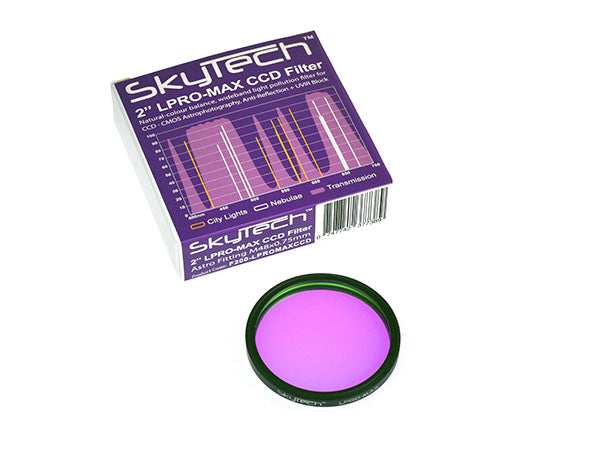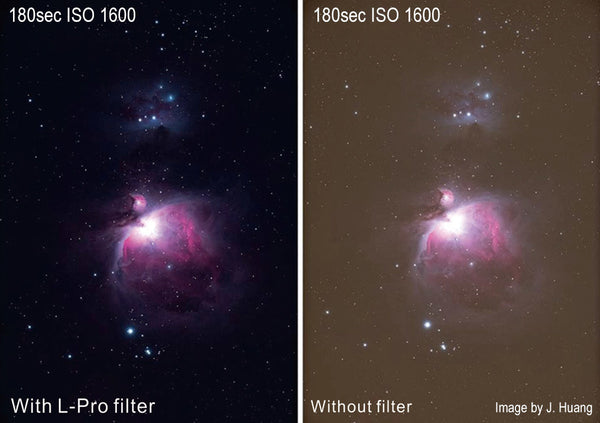The SkyTech LPRO-MAX filter is designed to improve the visibility of stars and deepsky objects, by blocking light pollution, while transmitting light from deepsky objects. It is therefore the best option for imaging in moderate light pollution where a more natural colour balance is desired.
Galaxies and nebulae: The Skytech LPRO-MAX is better for imaging galaxies than a CLS or UHC filter because it has a broader transmission band. This results in minimal colour cast on broadband emission targets such as galaxies, reflection nebulae and globular star clusters. Often emission nebulae are embedded in dusty areas which reflect light and these details are "lost" with Narrowband, UHC and CLS filters which transmit emission wavelengths and not much else. The LPRO MAX not only allows all the usual emission wavelengths through, but it also allows better visibility of dusty reflection nebulosity and dust. Both emission and reflection nebulae are covered with the LPRO-MAX.
Milky Way wide field imaging: The LPRO-MAX specially tuned passband gives an even more natural colour rendition than CLS or UHC filters because it allows more starlight through than UHC and CLS filters, giving a more natural looking milky way. Less post-processing is required to get rid of colour casts when using the LPRO-MAX.
Camera compatibility: SkyTech LPRO-MAX filters are suitable for colour and mono CMOS and CCD cameras. LPRO-MAX blocks UV and IR light, for sharper stars. LPRO-MAX special coatings are more complex to make than UHC and CLS coatings, therefore the cost is higher than these filters, however they transmit all the usual emmission wavelengths, with the added bonus of allowing more starlight and reflection nebulosity though. Mono cameras can also be used with the LPRO-MAX to capture Luminosity channel in LRGB imaging in light polluted areas. The LPRO-MAX 2" filter is compatible with the Altair Hypercam series CMOS cameras and telescopes (the LPRO-MAX screws into the front 2" nosepiece of the camera or a 2" eyepiece / adapter), as well as the Hypercam DSLR lens adapter (the LPRO-MAX 2" filter fits inside the housing behind the lens, protected from dust).
Visual use: LPRO Max provides a more contrasty view than CLS and UHC filters, and is a better choice for visual use where one desires to see galaxies and stars as well as nebulosity. Due to the wider band transmission, the LPRO-MAX filter is suitable for viewing deepsky objects with smaller aperture telescopes.
How this filter works: Artificial lighting such as mercury vapour lamps, both high & low pressure sodium vapour lights and unwanted natural light caused by neutral oxygen emission in our atmosphere (skyglow) are suppressed by the SkyTech LPRO MAX filter. The filter transmits light from deepsky objects, with high transmission of ionised oxygen O-III (496nm & 500nm), Hydrogen Beta / N-beta (486nm), N-II(654nm and 658nm), H-alpha(656nm) and S-II(672nm). Additionally it blocks UV (ultraviolet) and IR (infrared) light giving sharper stars. By selectively blocking light pollution and transmitting these desirable wavelengths, the contrast and detail of deepsky objects is greatly enhanced. Click image to see higher resolution (opens new window):
Technical Data:
Precision machined aluminium housing with standard "Astro" 2" filter thread (M48x0.75mm thread pitch).
Schott glass substrate material with precision polish.
Glass thickness 2.0 mm.
Surface Quality: 60/40
Fine-optically polished 1/4 wavefront and < 30 sec parallelism over both surfaces
95% transmission of main nebula emission lines (i.e. Ha 656nm, OIII 496nm & 500nm, SII 672nm and H-beta 486nm).
0.1% transmission of off-band, specifically the major emission lines of artificial light pollution (i.e. Na 589nm, Hg 435nm and 578nm).
Dichroic Filter Coatings:
Multi-layer anti-reflection coating (AR Coat). Additional UV IR Blocking layer.
Special high homogeneity coating process with electron-beam gun evaporation and Ion-assisted deposition coating technology for durability and resistance to scratching, as well as stability on CWL (central wavelength), no deviation with temperature change.





